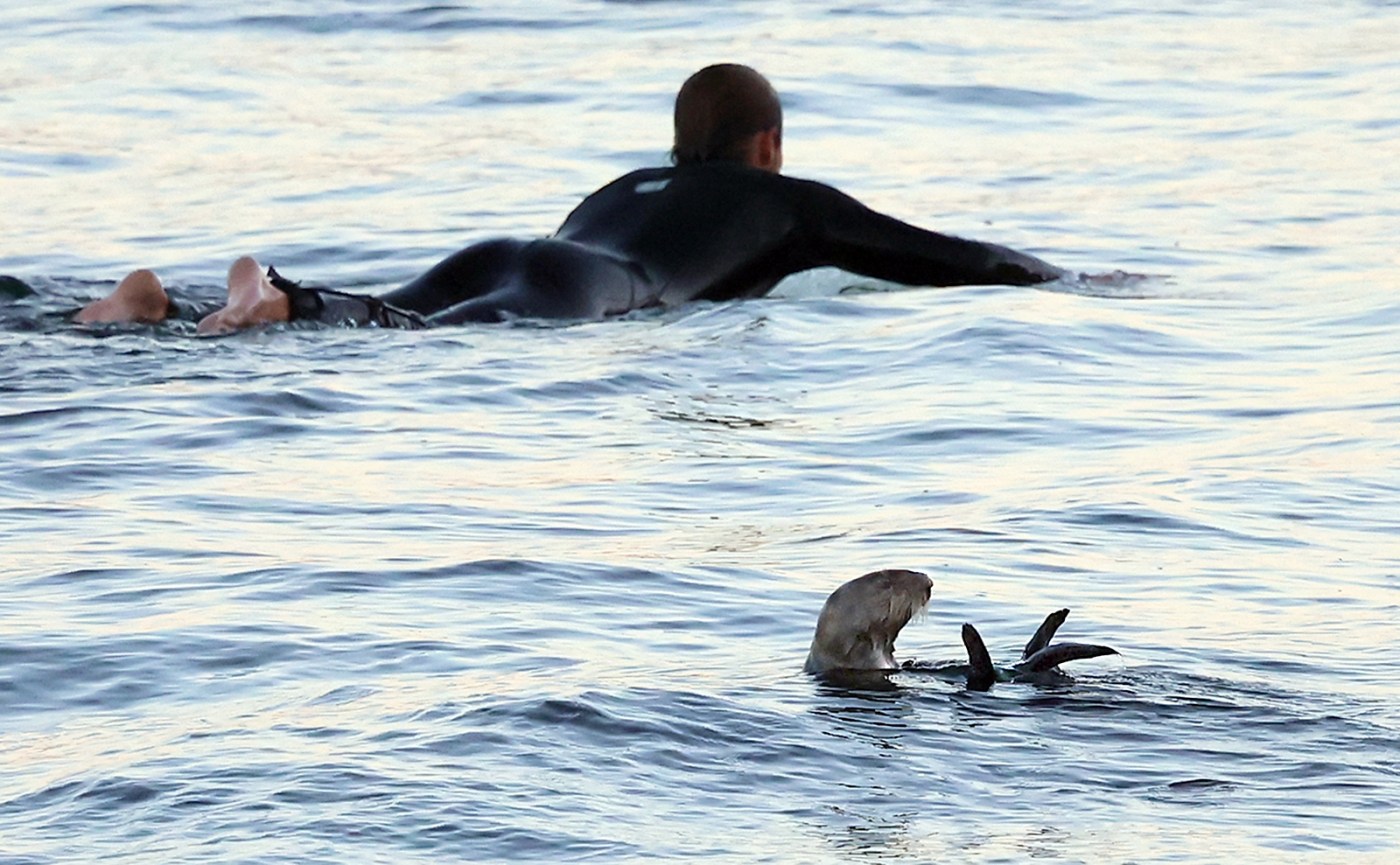SANTA CRUZ — When a colleague passed the photo along to sea otter expert Gena Bentall, she thought it was fake.
“The first thing I said was ‘That is 100% AI (artificial intelligence),” Bentall said with a chuckle. “Because that posture is so weird.”
RELATED: Otter steals surfboard in Santa Cruz. No, not that otter.
The viral picture, captured Thursday by Sentinel photographer Shmuel Thaler, depicts in its foreground a surfer gliding down the face of a wave at the iconic Steamer Lane break in Santa Cruz. But it wasn’t the surfer’s posture that was surreal to Bentall. Just beyond the curling wave and the surfer’s sprawling arms was a female southern sea otter that had thrust most of her body out of the water into an upright position so she could take a long, expectant look at the curious phenomena unfolding in front of her.
A sea otter pops vertically out of the water at Steamer Lane late Thursday afternoon to watch a waverider glide by near Lighthouse Point in Santa Cruz. On Wednesday, a sea otter commandeered a surfboard from a surfer and then on Thursday an otter chewed and pulled a different surfer’s leash. Many have been wondering whether the animal involved is the notorious Otter 841 who rocketed to international fame in 2023 when she was photographed forcing a surfer from their board in images by Santa Cruz County photographer Mark Woodward. After the incident, the marine mammal was fitted with a radio transmitter to monitor her activity. Fish and Game officials believe that Otter 841 chewed off her tracker, so no one is sure whether she is the otter currently interacting with surfers. At least four otters were swimming in the lineup at Steamer Lane on Thursday. (Shmuel Thaler – Santa Cruz Sentinel)
Bentall, director and senior scientist at Sea Otter Savvy, said the marine mammal will sometimes stretch its neck above water to inspect its surroundings if something feels amiss or threatening. The behavior is known as periscoping, but from what Bentall saw in the photo and heard described by people at the scene, this appeared to be an extreme version of it.
“The description of it sounds completely aberrant to me and my colleagues,” said Bentall.
The image arrived amid a pattern of unusual incidents at the famed Westside surf break that began Wednesday and continued Thursday. First responders helped one local surfer return to shore late Wednesday after an otter hopped onto the deck of her longboard and lounged atop its waxy surface for an extended period of time before swimming away.
A similar situation played out in the same area Thursday afternoon around the same time Thaler’s photo was taken. According to bystanders, there were at least two otters feeding directly in the “the lineup,” the pocket of ocean water where surfers assemble to wait for breaking waves.
Mark Woodward, a local photographer who captured photos of the Wednesday incident, returned to his same perch above Steamer Lane Thursday to see if the peculiar interactions would persist. His instincts were correct.
After initially finding the surfers and sea otters coexisting without incident, Woodward told the Sentinel he walked away to observe other parts of the coastline. But by the time he came back to his original spot about five minutes later, he saw that an otter had hopped onto another surfboard, only this time it was a shortboard.
“I guess (the otter is) trying out sizes,” Woodward joked.
A teenage surfer managed to shake the otter off the board and began to paddle away, but Woodward said the otter pursued the surfer and grabbed on to his leash while “literally at one point pulling him backwards.”
The surfer eventually managed to overpower the intrepid marine mammal and glide away while the otter shifted its focus back to feeding.
“(The otter) didn’t seem like (it) was going after the surfer at all. (It) just wanted that board,” said Woodward. “Once they lock on a certain board, that’s the one they focus on. They ignore the other boards around them and keep going after that one.”
A warning sign was stood up Thursday at the stairway that leads down to Steamer Lane cautioning those who enter to be mindful of their surroundings.
Related Articles
For a century, they were gone. But California Condors are making a comeback in these parts of the Bay Area
Wild bear wanders into Northern California zoo, ‘interacts’ with the resident bears
Taylor Swift’s sea otter shirt just raised $1 million for Monterey Bay Aquarium
South Bay humane society rehabilitates, releases hawk shot by BB gun
Otter steals surfboard in Santa Cruz. No, not that otter.
“Warning. Aggressive sea otter in this area. Enter the water at your own risk. Keep away from marine wildlife,” the sign read.
Santa Cruz Fire Department spokesperson Katie Lee said the signage had been provided to the city by U.S. Fish and Wildlife Service. The sign notes that any interactions can be reported to the Monterey Bay Aquarium at 831-648-4840.
In terms of a response from wildlife officials, Bentall said it’s her understanding at this time that no further action — including efforts to capture any otters — will be taken beyond the warning signs.
RELATED: Taylor Swift’s sea otter shirt just raised $1 million for Monterey Bay Aquarium
The Sentinel reached out to the California Department of Fish and Wildlife, but those officials deferred to counterparts at the U.S. Fish and Wildlife Service, since the southern sea otter is a federally protected species under the agency’s purview.
After emailing a staff member at the federal agency, the Sentinel received an automated response explaining that due to the current government shutdown, the worker had been furloughed and will return once funding appropriations were approved by Congress.
A representative from the Monterey Bay Aquarium said in an emailed statement that its sea otter program staff would follow the lead of federal fish and wildlife authorities if contacted for assistance.
Meanwhile, Bentall explained that the unflinching behavior of the otters can be viewed through the lens of human habituation. About 3,000 sea otters inhabit the waters just off the California coast and most of the territory they live and feed in is shallow enough to overlap with human activity. So in a location as famous as Steamer Lane that consistently attracts an abundance of surfers throughout the year, the otters may become more daring as their familiarity increases.
“The more prolonged the exposure of sea otters and their offspring are to human activities, the higher the likelihood that this is going to occur more frequently,” said Bentall. “This is just a product of our ubiquity in their habitat and it’s, in my mind, unavoidable and it’s probably going to get more common.”
It’s important to note, she added, that these interactions come with a high cost to the charismatic coastal creatures.
Unlike other marine mammals, otters have no blubber and rely instead on a thick coat of fur to keep warm in the frigid waters of the Pacific Ocean. But in addition to that, they must also constantly feed to maintain their body heat. Every time they encounter a human, otters have to shed energy that could be conserved by resting or used to find more food.
Sea Otter Savvy has seven to nine study sites along the Central Coast where it observes sea otter behavior. Otters across all of those locations have a daily average of six interactions with humans, according to Bentall.
“They cannot live their lives that way because of the high premium on energy,” she said.
U.S. Fish and Wildlife previously recommended that kayakers should keep at least 60 feet away from sea otters and avoid large kelp beds. Bentall also said Wednesday that if surfers come into close contact with an especially puckish otter, they should do what they can to discourage that behavior by swimming away, making noises or splashing lightly.
“I can’t speak to what’s going on in an otter’s brain that’s trying to get on a surfboard. I have no idea what the motivations are,” said Bentall. “But certainly that accustomation to the presence of people is contributing to it.”





